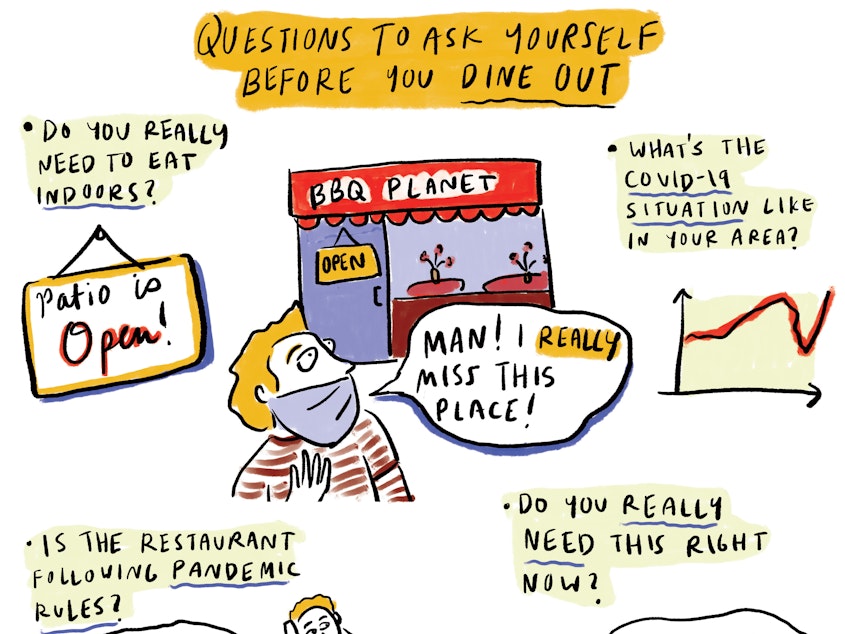Coronavirus FAQs: Is It Safe To Dine Indoors — Or Outdoors?

Some states are allowing restaurants to move back to indoor dining. But is it a safe idea to dine in right now?
People are definitely getting mixed signals about restaurant dining. In states such as Arizona and Tennessee, public health officials are urging people to stay home amid rising caseloads. Meanwhile, those states are offering outdoor and even indoor dining at restaurants.
The first question is, do you really need to eat in a restaurant? If someone in your family is immunocompromised or has symptoms of COVID-19, even if the family member hasn't been diagnosed, that would argue for avoiding restaurants altogether, says Harvard Medical School physician Abraar Karan.
But if you don't have such concerns and want a relaxing meal at a restaurant, here are some other points to consider.
First, outdoors is definitely less risky, says Karan. When you're outside, the risk of contracting the virus is lower. That's because coronavirus droplets disperse more quickly into the air. A bonus is that there may be more space between tables than in a small indoor setting.
Sponsored
You also need to do a little homework before dropping in for a meal, whether indoors or outdoors.
Dr. Mark Kortepeter, professor of epidemiology at the University of Nebraska Medical Center's College of Public Health, explains that unlike during pre-pandemic days, dining at a restaurant is no longer a pop-in, pop-out kind of situation. It's a good idea to call the restaurant and check what provisions it has in place to prevent disease transmission.
Here are some things to ask about:
Hand sanitizer. It should be available for customers upon entering and exiting.
Frequent cleaning. In addition to being wiped down, tables should be disinfected before each new party is seated.
Sponsored
Masks. Servers and kitchen staff should wear masks at all times to avoid transmission.
Screening. It's a good idea to eat at a place where staffers get temperature-checked before each shift and are asked if they're experiencing any COVID-19 symptoms — and if so, sent home. But keep in mind that there are limits to temperature screenings as a method to scout for the virus. So they're not a substitute for wearing a mask.
If you're set on an indoor meal, there are additional points to consider.
Good ventilation. Avoid small indoor spaces that feel cramped. The bigger the space, the better, usually — more airspace for viral particles to dissipate.
Space between tables. Guests should be seated as far apart as possible in the dining room — at least 6 feet apart, though more is better, per the Centers for Disease Control and Prevention.
Sponsored
Whether you're dining inside or outside, bring hand sanitizer and use it if you happen to come into contact with any frequently touched objects, such as door handles.
When ordering, Kortepeter invokes the old public health adage: "Boil it, peel it, cook it or forget it!" In other words, it's best to order hot, fully cooked foods instead of raw fruits or vegetables. Although scientists still aren't totally sure whether the coronavirus can be spread through ingestion, pathogens in general tend to thrive on moist, raw foods, say the researchers.
When we asked our sources if they planned to dine inside a restaurant at any time, both answered: not in the near future. They do feel more comfortable with outdoor dining — although they both said they're putting it off for now because of fears of transmission.
Some airlines like American are now fully booking their flights instead of keeping middle seats vacant. In that situation, how much riskier is flying? And are there any precautions you can take if you need to fly and cannot find an airline that's underbooking to help prevent disease transmission?
According to Karan, of Harvard, the move not to underbook flights represents a "mistake from a public health perspective." More people in a limited space for prolonged periods raises the risk of infection.
Sponsored
"Air circulation in planes is pretty good — so the biggest risk is the individual right next to you, right behind you, right in front of you," says Kortepeter, of the University of Nebraska. They're the most likely sources of infection.
In terms of keeping safe, all the usual tips apply, both sources say. Wear a mask at all times, and sanitize your hands as much as you can.
On a short flight, you might consider not eating or drinking anything, says Kortepeter — even food you bring yourself: "It reduces the chance of transferring virus" between your hands and your mouth and means you won't have to remove your mask, which serves to protect others in case you're contagious but can also offer you a degree of protection, depending on the type of mask.
On a longer flight, if you need to eat or drink, try to do it at one point in time. That way you'll reduce the amount of time you have your mask off, and you won't be repeatedly removing your mask and bringing your hands to your face.
And before you book a ticket, Kortepeter suggests you ask yourself: "Do I really have to fly?"
Sponsored
Pranav Baskar is a freelance journalist and U.S. national born in Mumbai, India. [Copyright 2020 NPR]



